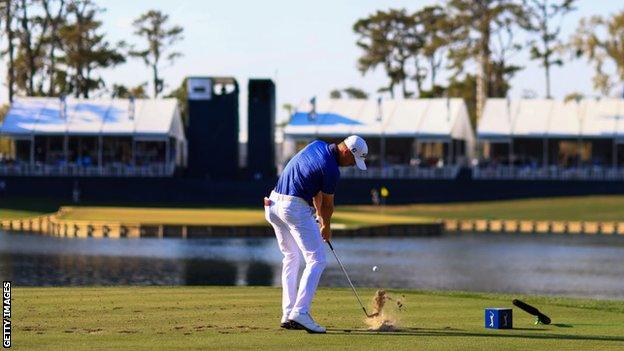Players Championship at Sawgrass: PGA Tour event to show golf is not broken
- Published
- comments

Justin Thomas goes into this week's Players Championship as the defending champion after the American beat England's Lee Westwood by one shot in 2021
The Players Championship |
|---|
Venue: Stadium Course, Sawgrass, Florida Date: 10-13 March |
Coverage: Live text updates of Saturday and Sunday's third and fourth rounds on BBC Sport website from 18:00 GMT, live commentary on BBC Radio 5 Live Sports Extra of final round from 20:40 GMT, plus in-play clips. |
Golf super league supporters argue the sport is "in desperate need of change".
That was the phrase used by Phil Mickelson in his recent and infamous statement of apology, one that did not say sorry to the PGA Tour but did make clear a desire to revolutionise the game.
Smaller fields, a reduction to 54 holes and a team concept with no cuts on a Formula 1-style global circuit, it is argued, is the way to go, especially when wealthy backers such as Saudi Arabia can put up millions of dollars in guaranteed money.
The disrupters claim 72-hole strokeplay, the staple of all the main tours, has had its day. It is, they say, too slow, boring and outdated for the modern sporting market.
But the status quo is nowhere near as broken as suggested. The best players enjoy fantastic wealth, earning it by climbing to the top of a pyramid founded on sporting legitimacy.
And the evidence of the past few weeks adds to the notion that settling golf tournaments over four rounds, in fact, remains the best way to showcase the sport.
The trend will surely continue this week at the Players Championship, the biggest event outside the four majors of the men's game.
The Players has a rich history and, the way things are going, even richer participants. This week they are playing for a record $20m purse.
There has been rapid inflation with the prize money comfortably out-sizing what is on offer at any of the majors. This is less to do with the threat of a breakaway and more about extra money generated by the PGA Tour's most recent television deals.
Media companies expect returns on such investment. So it is a pretty safe bet that broadcasters remain happy with 72 holes strokeplay.
Next Sunday the largest slice of the spoils - $3.6m - will likely go into the back pocket of one of golf's biggest and wealthiest stars. But there is no guarantee, which lies at the heart of the attraction of the current format.
Consider the Players Championship of 20 years ago when on holes 70, 71 and 72 a little known New Zealander Craig Perks was expected to fade from contention. Instead he produced a tournament-winning burst that stunned the golfing world.
On the 16th hole of his final round, the then world number 203 - who had missed 37 of 65 cuts in his tour career - chipped in for eagle. At the next he holed from 30 feet for birdie.
Then at the last he chipped in again to win by two strokes. He left, among others, defending champion Tiger Woods in his wake. "I've sort of lived off the finish for many years," Perks recently told Golf Digest.
"And I've been thankful for the opportunities it's created, and for the memories that get rekindled. It never gets old because it's so memorable, I guess, to so many people."
It would never have happened if the field was just 48 golfers and the tournament only 54 holes.
Many leading players claim tours' huge incomes from broadcast and sponsorship deals are solely down to them. They are the biggest stars; the poster boys who feel they deserve a bigger share of the spoils.
Those pushing for a breakaway want to capitalise on this apparent unrest among already multi-millionaires. This is why $40m was shared among the biggest needle-waggers through the PGA Tour's inaugural Player Impact Programme (PIP).
The PIP pot, rewarding a pro's celebrity rather than performance, swells to $50m this year. But this ethos ignores a fact that these leading players cannot achieve their elevated status without regularly beating the sizeable rump of journeymen - a relative term - on tour.
These lesser lights are extraordinarily skilful and, as Perks proved, capable of winning on a day when the stars align.
Shaun Micheel once told me he is a "hot dog golfer." Elaborating with a laugh, the American veteran said: "Fans see my name on the player board coming down their hole, and they say 'ah it's Micheel, let's go get a hot dog!'"
Well, no one rushed for Oak Hill's fast food stalls when he fired a 7-iron to two inches on his final hole to win the 2003 US PGA Championship. It was a lightning in a bottle moment, one of those occasions that help make pro golf what it is.
Such moments will not emerge from a travelling circus of 48 players.
When 23-year-old Joaquin Niemann won the Genesis Invitational at Riviera last month he broke into the world's top 20. He beat a stacked field and was the first since Charlie Sifford in 1967 to triumph in LA by leading after every round.
After two of them he was two strokes clear, after the third he was three ahead and during the final circuit the young Chilean led by five.
But the tournament went all the way to the closing hole before his historic victory was confirmed because of a stellar final-round charge by Open champion Collin Morikawa. It was fabulous sporting drama.
A week later Daniel Berger would have won by five shots if the Honda Classic were a 54-hole event. Instead the American buckled at the start of the final loop and Sepp Straka burst through to become the first Austrian to post a PGA Tour win.
Think about the way Thomas Pieters and Viktor Hovland surged victoriously on the final days of the two biggest events so far this year on the DP World Tour in Abu Dhabi and Dubai respectively.
Think of the 750,000 fans who revelled in the party atmosphere of the Waste Management Open in Arizona. Chucking beer cans on the course was too much, but the overall vibe showed how attractive to the masses golf in its current form can be.
And think of the fans who will swarm around the 17th hole island green and elsewhere on Sawgrass' Stadium Course for each of the four days of the Players Championship this week.
For three and a half rounds they will be captivated by the world's best players battling the course and conditions. Then the tournament will morph into man versus man coming down the stretch.
Super-leaguers want to provide a short cut to that point. The one at which, they argue, golf finally gets interesting.
But they forget that it is the journey to those moments - the player and his livelihood against the course - that gives the crescendo its true value. People enjoy it, TV likes it and a lucrative international circus is founded and flourishes upon the whole package.
Yes, there is plenty in pro golf that can be improved, but think twice before being lured into thinking this is a broken system in need of a radical fix.
